We Hope You Enjoy Your DIY Valentine Crystals
Are you and your kids looking for an engaging Valentine’s Day STEM activity? Our DIY Valentine Crystals investigation will take you and your kids deep into the world of crystallization. We researched a variety of methods, using different materials in different scenarios. We had a lot of fun, especially with our heart geode. If you have a rock hound or two in your family, this could be the perfect activity for them.
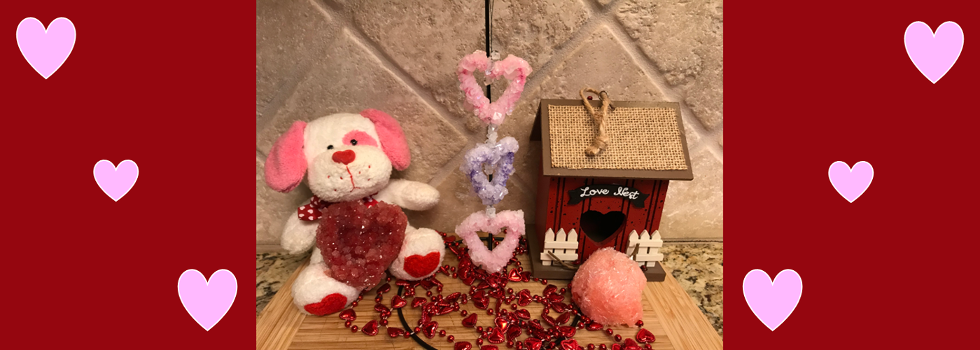
DIY Borax Valentine Geode Crystals Printable Instructions
DIY Epsom Salt Valentine Crystals Printable Instructions
Safety Warning: Keep all chemicals used in this activity away from younger children. Avoid unnecessary contact, don’t rub it in your eyes, and do not ingest it.
Adult supervision is required for this project.
Crystal growth in rocks can take millions of years to form. While your Valentine crystals won’t take this long, the three crystallization methods we investigated did have to sit overnight. The alum powder and Borax crystals needed to sit in the saturated solution overnight for decent crystal growth. And although the Epsom salt crystals formed after only sitting in the chilled, saturated solution for 4-5 hours, we found these finer crystals easier to handle after drying overnight.
Note: Please be aware that you need to boil water during this activity. This may not work in a classroom setting.
Do you need another Valentine’s Day STEM activity to do while your kids wait for their crystals to form? Have you decided that the Valentine Crystals won’t work in your classroom setting? Then check out our Case of the Broken Valentine Circuit investigation. It’s been a big hit with students in the past, and with just conductive copper tape, LEDs, and a battery your kids can learn about electronics as they create paper circuit Valentines.
The Science Behind Crystals
Crystals
A crystal is defined as a solid material formed by molecules connected in a repetitive pattern, called a crystal system. If you look at a crystal closely, you will see that it was formed with straight edges and flat surfaces. It may take time for mother nature to form dazzling crystals such as amethysts and quartz, but did you know that salt and sugar are crystals too?
Crystal System
A crystal system is defined as one of seven categories of crystals classified according to the possible relations of its crystal axes. These categories include the cubic, tetragonal, orthorhombic, trigonal, hexagonal, monoclinic, and triclinic crystal systems. Each system is recognized by the geometric parameters of its unit cell, which is the simplest repeating unit in the crystal.
Crystal Investigation
Do your kids have access to a magnifying glass or microscope? Can you get your hands on some crystals? If you were able to answer yes to both questions, your kids may enjoy doing an investigation of their own. Help them gather the facts, record their observations, and see if they can guess which crystal system they’re looking at. Our Crystal System Guide for Beginners can help them get started. You can also encourage them to go online for additional information.
Note: Don’t forget, salt and sugar are two common household crystals your kids can start their investigation with. Salt is made of tiny cube-shaped crystals, putting it in the cubic system. Sugar is made of crystals that are oblong shaped with slanted ends, putting it in the monoclinic system.
DIY VALENTINE CRYSTALS RECIPES
We investigated three popular DIY Crystal ‘recipes’ this month and saw images of some very stunning crystals online. But which of these recipes worked the best? We were surprised to find that all three methods formed amazing crystals for some people, yet for others, the only thing that grew was their kid’s disappointment. In the end, we decided to test all three methods. We created quite a few alum powder, Borax, and Epsom salt crystals. Unfortunately, these crystals didn’t always turn out the way we thought they would. But which crystals were our favorite? Which of the three methods worked best for us? Which method do we recommend you try with your kids? Check out our Investigation Tab below to find the answers to these questions and more.
Supply List
Borax DIY Valentine Crystals Supply List
| Materials | Tools |
|---|---|
| Borax | Stove or Microwave |
| Pipe Cleaners | Measuring Cup & Tablespoon |
| Water | Stirring utensil |
| Food Coloring - Optional | Scissors |
| Clear Sealant - Optional | Needle & Thread |
| Container for the Crystal Base/Saturated Solution. | Pan or Microwave Safe Dish |
Note: We built our Valentine heart geode with 5 pipe cleaners and two cups of a saturated solution containing 14-15 tablespoons of Borax for a total project cost of $1.00, but the upfront cost for a box of Borax will run around $6.00 at your local big box stores. You should be able to find the rest of the necessary materials and tools around your house.
Epsom Salt DIY Valentine Crystals Supply List
| Materials | Tools |
|---|---|
| Epson Salt | Stove or Microwave |
| Water | Measuring Cup & Tablespoon |
| Food Coloring - Optional | Stirring utensil |
| Container for the Saturated Solution | Pan or Microwave Safe Dish |
Note: The cost for your Epsom salt crystals depends on the amount of saturated solution you create. Keeping your solution to a 1:1 ratio (equal parts Epsom salt and water), you can create crystals from a 1/2 cup of the saturated solution for around $0.33, but the upfront cost for a bag of Epsom salt can run around $6.00 at your local big box stores. You should be able to find the rest of the necessary materials and tools around your house.
Investigation
We investigated three popular methods of growing our DIY Valentine crystals this month. While these three methods are very similar, they differ in the main starter ingredient for the crystallization process, and what ‘base’ the crystals will grow on.
CRYSTAL STARTER
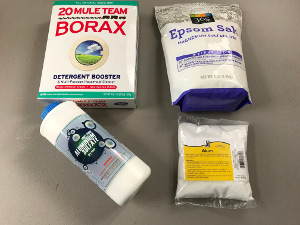
We tested alum powder, Borax, and Epsom salt for our crystal starters. During our research, we found that not all alum powder is the same. The alum powder method will only work if your powder contains potassium aluminum sulfate. We purchased alum powder with and without the potassium, just to verify that the potassium is needed. It is.
THE WINNER
Borax from our local big box store.
INVESTIGATION RESULTS
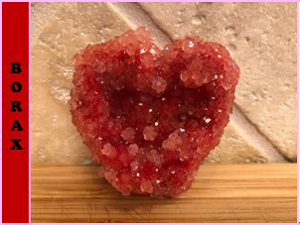
» The Borax solution grows the largest crystals, and the crystals grow consistently.
» Borax is inexpensive and easy to find.
» The Borax crystals have to sit overnight for optimum formation.
» The food coloring used in the solution will fade unless you seal your crystals. We sprayed ours with two coats of clear enamel spray once they were dry.
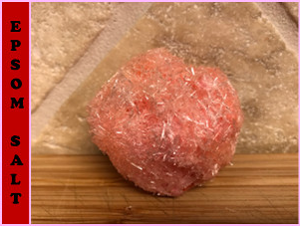
» The Epsom salt solution forms a fine, needle-like crystal when chilled.
» Epsom salt is inexpensive and easy to find.
» Epsom salt crystals form within 4-5 hours if chilled. They don’t need a base to grow on, but the crystals break easily. It helps to have something to hold on to once the crystals are dry. You can try leaving something on the bottom of the container or weigh down a piece of heavy string and dangle it from the top of the container similar to the Borax crystal method.
» These crystals don’t take as long to form, but they need to be handled gently.
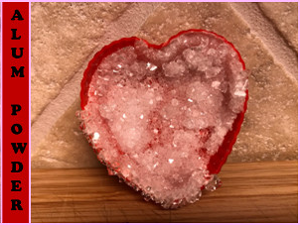
» Only alum powder with potassium aluminum sulfate will create crystals.
» The alum powder crystals are similar to the Borax crystals.
» Alum powder with potassium aluminum sulfate is more expensive than Borax and Epsom salt, and harder to find.
» The glue needed to attach the dry alum powder to the base does not stick well to silicone molds.
» The alum powder method takes an extra day to complete. The alum powder must be glued to your crystal ‘base’, then completely dried, before working on your saturated solution.
» The silicone molds were too light. Our first batch moved around or tipped over, contaminating the jar as we poured in the solution. Unfortunately, these contaminants also started growing crystals, keeping the crystals growing in our heart-shaped base from being optimum size.
Note: Adding the saturated solution to the container before placing our heart in the solution would have worked better.
» Once we order more alum powder, we want to try these crystals again, but only out of curiosity. We recommend you create your crystals using a Borax solution. It’s more cost-effective and consistent.
BASE MATERIAL
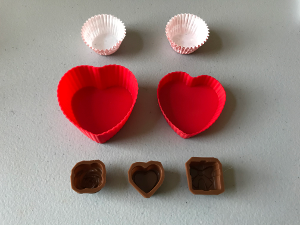
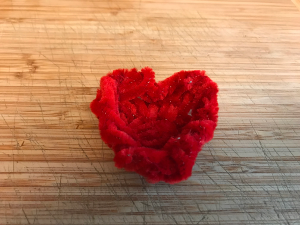
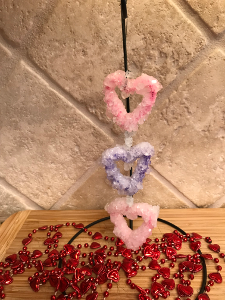
We tested quite a few materials for the base of our alum powder crystals. And we tested several pipe cleaner shapes for our Borax crystals. In the end, the 3D heart and the chain of hearts were our favorite (see above images).
THE WINNER
The 3D heart formed out of pipe cleaners. The depth of the 3D heart resulted in a geode-style crystal formation.
INVESTIGATION RESULTS
» The crystals will grow on the thread holding the pipe cleaners. We liked seeing the crystals on the thread, especially with our chain of hearts (see image above). An alternative would be to use some fishing line instead.
» The 3D pipe cleaner crystal base works best when the pipe cleaners are tightly formed.
» Make sure your pipe cleaner base doesn’t touch your container while it’s hanging in the saturated solution. Otherwise, it could adhere to the container as your crystals grow.
» If your kids designed a geode pipe cleaner base, and they want most of the crystals to form inside the ‘geode’ hang it with the hollow side facing up. Crystals don’t seem to form on the underside of pipe cleaner crystal bases.
Note: We created a 3D diamond shape out of pipe cleaners and discovered that the crystals only formed on the top half of the diamond. We tested a second 3D shape with the same results. There seems to be a limited amount of crystal formation below the widest section of a 3D pipe cleaner shape (See image below).
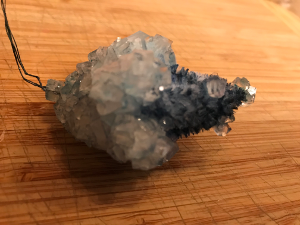
ADDITIONAL INVESTIGATION TIPS
» If you use food coloring, be sure to add it after adding the Borax, otherwise you won’t be able to see when the Borax solution starts to get cloudy or when the extra powder settles on the bottom.
» If you use food coloring, the lighter the better if your kids want to monitor their crystal growth. We couldn’t see through the dark red solution we used for our heart geode.
» If you do try alum powder crystals, be sure to pour your saturated solution into the container before adding your crystal base.
» Move the container holding your kid’s crystals as little as possible.
» Your crystals may be fragile when they’re wet, but they will harden as they dry.
» You may notice that some crystals formed on the bottom and sides of your container. These crystals can be removed by pouring boiling hot water over them when it’s time to clean up.
Borax Crystals
DIY Borax Valentine Geode Crystals Printable Instructions
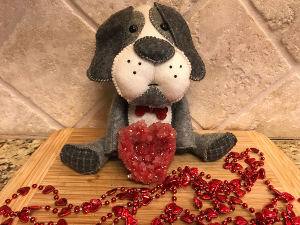
The Borax Valentine geode crystals were our favorite crystals, and it’s the method we recommend you try with your kids. The finished crystals are a nice size, and they’re strong enough to be handled by your kids once they’re dry. You can find Borax in the laundry detergent aisle in most big box stores, and it’s relatively inexpensive to purchase.
We made a 3D pipe cleaner heart for our crystal base, but this is the one area your kids can be creative. We also made a Chain of Hearts which you can see in the picture at the top of this post. Just remember to be careful how you hang your kids’ crystal base once they’re finished forming it. As we discussed in our Investigations Tab, there won’t be a lot of crystal formation on the underside of a 3D base.
What’s Happening
During this project, you will help your kids dissolve Borax powder, also known as sodium borate, into hot water. You will continue to add Borax to the hot water, one tablespoon at a time until the solution has become fully saturated. You will know your solution is fully saturated when the hot water starts to become cloudy and Borax powder starts to settle on the bottom of the pan.
As you cool your saturated solution, crystals will appear on your pipe cleaner crystal base. This occurs because hot water can hold more Borax than cold water, causing crystals to form as the Borax ‘falls’ out of the solution. The hot water can hold more than the cold because the higher the temperature of the water, the more space between molecules, allowing more room for the powder.
Note: If you keep your container of Borax solution warm so it cools slowly, larger crystals should form.
Step 1 – Supplies:

Note: You will want to make sure your solution container is large enough to hold your kid’s crystal base.
Step 2 – Procedure:
You and your kids have your supplies ready to go, now all you have left to do is follow the steps below and have fun!

2.1 The first step is for your kids to create the pipe cleaner shape they’d like to use as their crystal base. Your younger kids may need help with this step since 3D shapes need to be tightly formed for the best crystal formation. This is the one step where your kids can be creative. The only limit is their imagination, and the size of the container you will be hanging the crystal base in (see Image 2.1).
Note: We created our 3D heart shape with 5 red pipe cleaners, and ended up with a nice, dense set of geode type crystals. We created three pipe cleaner heart outlines, each one a little smaller than the last, then wove them together in a stack going from largest to smallest. We finished our heart by weaving the rest of the pipe cleaners around each other for the bottom of our heart, connecting the bottom to the sides as we went.
2.2 Once your kids have finished their crystal base, help them tie their crystal base to a popsicle stick or something similar. Be sure to tie the thread to the smallest end of your kid’s crystal base so that the largest part of the base is at the bottom. As we discussed near the bottom of our Investigations Tab, crystals don’t seem to grow on the underside of 3D bases as well (see Image 2.2).
Note: Crystals will most likely grow on the thread as well as the pipe cleaners. If this is something you’d like to prevent, use fishing line or something similar instead. The crystals are less apt to form on the smoother material. If your kids would like to hang their completed crystals, you could let them pick out some ribbon. It will be sturdier than thread and look more elegant.
2.3 Hang your crystal base in your container, wrapping any extra thread around your popsicle stick until you like the height of your base. Near the bottom half of the container, without touching the bottom or sides of the container, is a good location. Once you’re happy with the location of the crystal base, tape the thread on the popsicle stick (see Image 2.3).

2.4 Measure the amount of water your solution container can hold, then round this amount up to the nearest cup. This is the amount of water you will want to add to your pan (see Image 2.4).
2.5 Bring your pan of water to a boil, then remove from heat (see Image 2.5).
2.6 Add Borax to the hot water, one tablespoon at a time, stirring continuously until the water is fully saturated. Your water will be fully saturated with Borax when it starts to look cloudy and you can see the powder start to settle on the bottom of the pan (see Image 2.6).
Note: We used 6-7 tablespoons of Borax per cup of water for our geode crystals before our water started to look cloudy.

2.7 If your kids have decided to color their crystals, add the food coloring to your saturated solution now, then bring the solution to a boil one more time. This will allow the last of the Borax to dissolve since the hotter the water the more Borax it can hold. Plus, you want your solution as hot as possible before pouring it into your container (see Image 2.7).
2.8 Carefully fill your container with the saturated solution, then gently place your pipe cleaner crystal base in the solution until the popsicle stick rests on the top of your container. Make sure that your pipe cleaner base isn’t touching the bottom or sides of your container or the pipe cleaners will harden to the container as the crystals grow (see Image 2.8).
2.9 For larger crystals, place your container filled with the saturated solution & crystal base in a pan of hot water so it cools down slowly (see Image 2.9).

2.10 Once the water in the pan from step 2.9 has cooled, you can carefully remove the container and let it sit overnight for optimum crystal growth. You may want to leave it in an area where your kids can check how their crystals are growing without moving the container (Image 2.10).
2.11 The next morning, carefully remove your kid’s crystals from the container and set them on a rack or paper towel to dry (see Image 2.11).
Note: You can trim the thread and any crystals that grew on it at this time.
2.12 Once your kid’s crystals are dry, you may want to seal them, so the food coloring doesn’t fade. We used a spray can of clear finish on our Valentine heart geode, but you can also use nail polish or another clear sealant you have around your house (see Image 2.12).
Epsom Salt Crystals
DIY Epsom Salt Valentine Crystals Printable Instructions
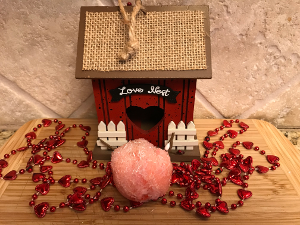
Epsom salt crystals are worth doing with your kids, but as a lesson on crystallization. The thin, needle-like crystals make a nice contrast to the larger crystals created with the Borax solution. Epsom salt crystals are easy to make, inexpensive, and don’t take as long to form in a chilled solution.
What’s Happening
During this project, you will help your kids dissolve Epsom salt, made up of magnesium sulfate, into hot water. You will use a 1:1 ratio of Epsom salt and hot water to create your saturated solution. You should notice your water turn cloudy, and you may see some Epsom salt crystals settle on the bottom of the pan.
As you cool your saturated solution, crystals will start to form. This occurs because the hot water can hold more of the salt than cold water, causing crystals to form as the salt ‘falls’ out of the solution. The hot water can hold more than the cold because the higher the temperature of the water, the more space between molecules, allowing more room for the salt.
Step 1 – Supplies:

Note: You only need a small amount of solution on the bottom of your container.
Step 2 – Procedure:
You and your kids have your supplies ready to go, now all you have left to do is follow the steps below and have fun!

2.1 The first step to making some thin, needle-like crystals is for you and your kids to decide how much Epsom salt solution you want to make so you know how much hot water you need. You will be using equal parts water and Epsom salt for these crystals, so make sure you have enough salt on hand. Now heat your water. You want the water to be as hot as possible, without it boiling (see Image 2.1).
Note: You only need a small amount of solution at the bottom of your container, but you can have more. We filled one of our containers with around 2″ of the solution, resulting in a nice red snowball. You may also want to fill several containers, have your kids place them in different environments, and see if they can predict how the crystals will grow in those environments.
2.2 Once the water is hot enough, help your kids add the same amount of Epsom salt as they did water, then stir the solution for about two minutes. Remember, you want this to be a 1:1 ratio of water and Epsom salt (see Image 2.2).
2.3 You can now have your kids add the food coloring to the solution and stir it one more time (see Image 2.3).

2.4 Help your kids pour the solution into their container (see Image 2.4).
2.5 Place the container in the refrigerator to chill for 4-5 hours (see Image 2.5).
2.6 Once your crystals have formed in the refrigerator for 4-5 hours, drain the excess solution out of the container, and let the crystals dry overnight (see Image 2.6).
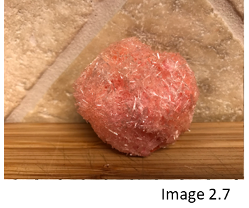
2.7 Hopefully, your Epsom salt crystals came out great (see Image 2.7).
